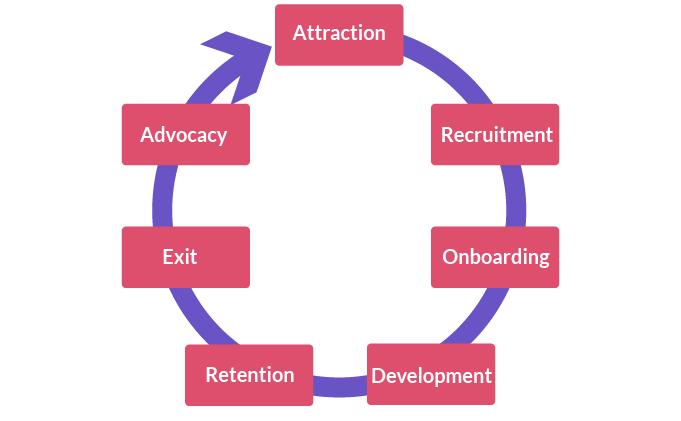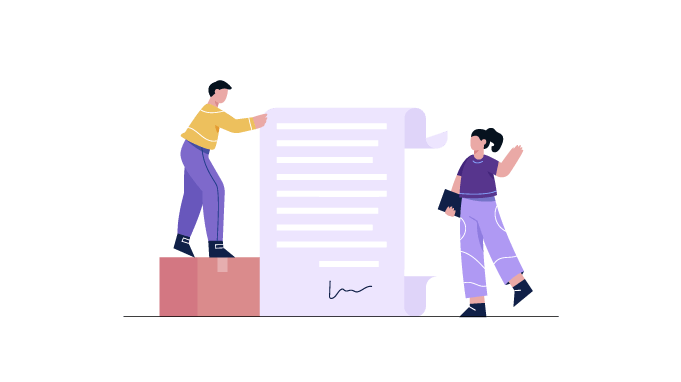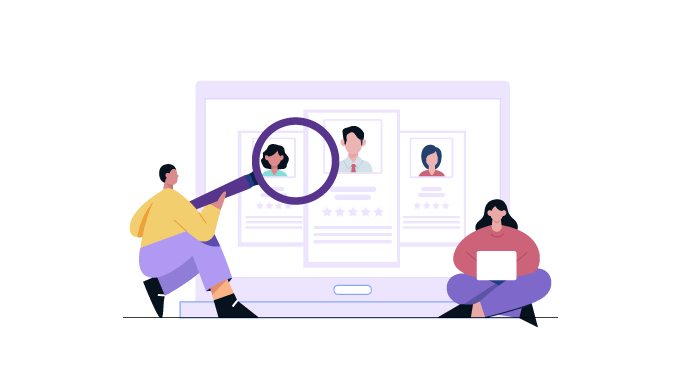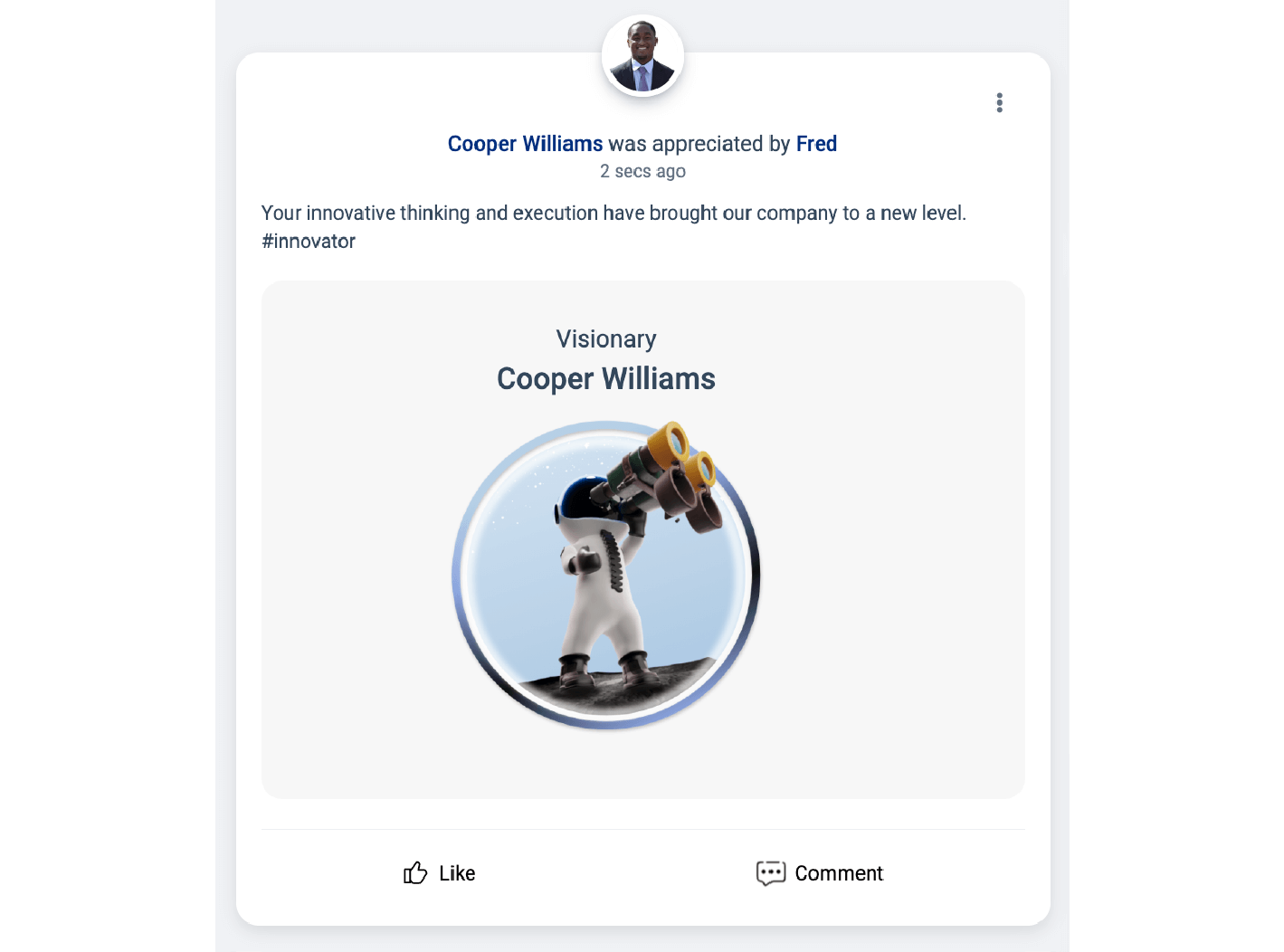7 Stages of Employee Lifecycle That You Need to Know for Effective Management
The employee lifecycle covers an individual's entire journey, from the moment they are recruited until their eventual departure. It's not just about hiring the right people but also about nurturing and retaining them.
Therefore, a comprehensive understanding of these stages will help you optimize the employee experience and cultivate a collaborative environment.
In this blog, we'll explore the distinct stages of the employee lifecycle, shedding light on the key considerations and best practices for effective employee management at each juncture.
Key Takeaways
- What is Employee Lifecycle?
- Looking at the Benefits of Employee Lifecycle Strategy
- Understanding the 7 Stages of Employee Lifecycle
- How Employee Lifecycle Management Can Help?
What is Employee Lifecycle?

The employee lifecycle refers to an employee's entire journey within an organization, from the initial recruitment stage to their eventual exit or retirement. It consists of all the phases and touchpoints an individual experiences during their employment tenure.
It serves as a framework for organizations to align their strategies, policies, and practices to support and engage employees throughout their tenure.
Organizations can optimize employee experience, foster engagement, and ultimately drive organizational success by understanding and effectively managing each stage.
Benefits of Employee Lifecycle Strategy
1. Improved Recruitment and Hiring Process
A well-structured employee lifecycle strategy helps attract and hire the right talent for your organization.
By clearly defining job roles and expectations, organizations can streamline their hiring process and match with candidates who align with the company's goals.
This clarity fosters a sense of purpose from day one. It also lays the foundation for long-term employee engagement and productivity.
2. Enhanced Employee Engagement
A well-designed employee lifecycle strategy provides a structured framework that nurtures a sense of belonging and engagement among employees from the very start. It provides a roadmap for meaningful interactions at every stage of an employee's journey.
From the initial onboarding process to career development opportunities, this model ensures that employees feel valued and invested through regular feedback and recognition.
3. Increased Retention Rates
The employee lifecycle model boosts retention rates by addressing key factors influencing an employee's decision to stay with an organization.
It prioritizes work-life balance, competitive compensation, and benefits to create a positive organizational culture that directly impacts employee retention.
4. Streamlined Onboarding Process
It ensures a smooth and effective integration of new hires into the company's culture, roles, and expectations.
It immerses them in the company's mission, vision, and strategic objectives, fostering a sense of purpose and alignment from day one.
When new hires feel supported and equipped with the tools they need to thrive, they are more likely to contribute positively to the company's goals and culture.
5. Continuous Learning and Development
The lifecycle model ensures that learning is an integral part of the employee experience. Starting from the initial onboarding phase, where new hires are introduced to training programs and resources, to ongoing development opportunities.
This emphasis on continuous learning enhances individual skill sets and knowledge. It also contributes to a culture of innovation and adaptability within the company.
7 Stages of an Employee Lifecycle
1. Attraction

The attraction is the first phase of the employee lifecycle. It is focused on identifying and capturing the interest of potential candidates for open positions within an organization.
The attraction stage involves implementing strategies such as establishing a strong employer brand and creating transparent job descriptions representing the role.
For instance, showcasing your company's cutting-edge projects could be compelling if you are seeking innovative tech professionals. However, if your focus is on attracting creative talents, emphasizing a vibrant and collaborative work environment might be more effective.
You can also utilize incentivized referral programs to encourage existing employees to refer qualified candidates from their networks. This helps you tap into their connections for talent acquisition.
2. Recruitment

The second stage involves hiring the right people for the right job. This critical step includes streamlining the hiring process and making informed decisions about prospective employees.
To identify qualified candidates, you need to have a good hiring strategy in your organization to make the most out of the recruitment process. You need to be specific and relevant about the job you offer.
Structured interviews, skill assessments, personality evaluations, and other tools can be used to vet candidates' competencies and potential thoroughly.
Additionally, providing candidates with constructive feedback during and after the interview process helps foster a positive candidate experience. Once the evaluation process concludes, you must be prompt in extending the job offers to the top candidates.
3. Onboarding and Orientation

Once hired, new employees undergo an onboarding process to understand the organizational culture. It sets the foundation for a successful and productive employee experience.
During this stage, employees are introduced to the company's mission, values, policies, procedures, and expectations. The orientation process helps new hires gain the necessary knowledge, skills, and tools to perform their job duties effectively.
A smooth onboarding process is essential for an employee to fit right in the organization. Not only will it ease their anxiety, but it will also increase employee engagement.
4. Development

The development stage of the employee lifecycle involves ongoing growth and learning opportunities for employees within the organization.
During this stage, employees are encouraged to enhance their skills and knowledge through various training programs, workshops, and educational opportunities.
Regular performance reviews and constructive feedback are also conducted to identify areas for improvement. This helps employees stay relevant in their roles and prepare for advancement throughout their tenure.
5. Retention

The employee retention stage is the fifth and most crucial stage in the employee lifecycle model. The sole focus during this stage is on retaining the organization's top and most valuable employees.
In this stage, organizations implement strategies and initiatives to keep their employees engaged and motivated. They achieve this by fostering a positive work environment that promotes open communication, transparency, and work-life balance.
Furthermore, offering rewards and recognition to employees for their achievements in the workplace is another key aspect that helps in retaining employees. This practice acknowledges their hard work and motivates them to continue excelling in their roles.

Source: Vantage Rewards
6. Exit or Offboarding

A negative offboarding experience can lead to 60% of former employees speaking negatively about the company (Source: HBR).
The offboarding phase occurs when employees choose to depart from your organization. This departure can result from voluntary resignation, termination, or retirement.
The offboarding process involves conducting a formal exit interview with the departing employee. This interview aims to gather valuable feedback on the employee's experience, reasons for leaving, and suggestions for improvement.
This stage also facilitates the seamless transfer of knowledge, responsibilities, and ongoing projects from the departing employee to minimize disruptions in the workflow.
7. Advocacy
Employee advocacy transcends the traditional stages of the employee lifecycle model. It is an ongoing phase that begins when an individual joins the company and continues even after their tenure has ended.
This stage includes actions and behaviors of both current and former employees in promoting and representing the organization. They are encouraged to act as brand ambassadors and actively champion the company in a positive light across their personal and professional networks.
For instance, they are involved in sharing positive experiences and stories on social media platforms to enhance branding and expand market reach. And this is only possible when the employees have a positive experience during their tenure.
How Employee Lifecycle Management Can Help?
Employee lifecycle management is a comprehensive and strategic approach that focuses on effectively managing employee lifecycle. It involves aligning HR practices, policies, and programs to support and enhance the employee experience.
1. Attracting Top Talent
A well-defined employee lifecycle management can significantly impact how companies attract top talent.
Crafting compelling job descriptions is a crucial step in this journey. By highlighting the company's culture, values, and unique opportunities, you can attract candidates who resonate with the organization's goals and vision.
When it comes to recruitment, you can streamline the process and make it easier for candidates to apply by using user-friendly application portals or platforms.
Additionally, you can showcase your employer brand on social media and professional networks by sharing testimonials, behind-the-scenes glimpses, and company achievements to build credibility.
Employee referral programs and competitive compensation packages further enhance a company's attractiveness to potential hires.
2. Boosting Engagement and Retention
According to a Gallup report, engaged employees are 17% more productive than their disengaged counterparts.
Employees who feel supported and valued throughout their lifecycle are more likely to be engaged and committed.
A comprehensive onboarding process sets the tone for a positive employee experience. Tailored onboarding programs, along with mentorship, ensure that new hires feel welcomed and equipped from day one.
Additionally, recognition and appreciation for employees' contributions go a long way in boosting employee morale and motivation. This can be done with the help of employee recognition programs that highlight outstanding performance and achievements.
Furthermore, implementing wellness initiatives that promote work-life balance and employee well-being helps in improving employee retention.
3. Performance Improvement
As employees advance in their positions, consistent feedback plays a vital role in their growth and development. It helps to gain deeper insights into employees' experiences, perceptions, and areas for improvement.
In this regard, employee lifecycle surveys serve as a powerful feedback mechanism. It enables organizations to gather invaluable insights from employees at various stages of their journey within the company.
One of the primary benefits of these surveys is the ability to identify pain points and areas for improvement. It allows you to monitor the effectiveness of employee lifecycle initiatives and make data-driven adjustments as needed.
4. Career Development
Employees are inherently drawn to organizations that offer opportunities for growth and prioritize their professional development. Therefore, nurturing this aspect by providing avenues for skill enhancement and career advancement is crucial.
Through initiatives such as training programs, workshop and mentorship opportunities, organizations can empower their workforce to thrive. These programs enhance employees' capabilities and boost their confidence to contribute meaningfully to the organization.
Additionally, strategic career path planning helps employees have clear visibility into their future within the organization. This clarity motivates employees to actively pursue development opportunities that align with their career aspirations.
5. Smooth Transitions
Effective employee lifecycle management can make a significant impact in facilitating smooth transitions for employees at various stages of their careers.
Managing the exit process with the same diligence as the onboarding process is paramount for organizational success. While onboarding sets the stage for new employees' success, proper offboarding ensures a smooth transition for departing employees.
Conducting exit interviews, documenting processes, and arranging knowledge transfer sessions can ensure that critical information is passed on to the relevant parties. This helps to maintain operational efficiency and minimize disruptions to the organization.
Conclusion
In conclusion, understanding and effectively managing the stages of the employee lifecycle is paramount for fostering a thriving organizational culture.
From the initial attraction and recruitment stages to the final phase of advocacy, each step plays a crucial role in contributing to overall organizational objectives. Therefore, embracing the power of employee lifecycle management can pave the way for a thriving workplace full of innovation, productivity, and growth.



















